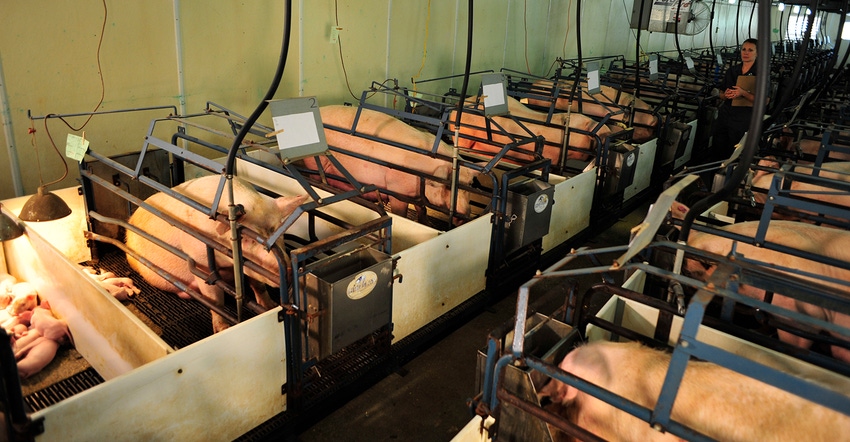ERS examines impact of state sow welfare policies on pork production
By 2026, it is estimated the gestation crate bans will impact more than 7% of the U.S. breeding sow herd and almost 18% of breeding operations.
December 30, 2022

The USDA’s Economic Research Service recently released a comprehensive report, detailing all of the state farm animal welfare policies, the extent of their implementation and the challenges these policies have faced. Since 2002, 14 U.S. states have passed and implemented legislation that directly impacts U.S. livestock production practices. Ten states have specifically banned the use of gestation crates for sows.
In 2002, Florida became the first state to pass a farm welfare policy addressing the use of gestation crates or stalls in pork production within the state’s production. While the amendment made provisions for crate use immediately prior to birth, it prohibits routine confinement of pregnant sows.
In the last 20 years, another nine states have followed suit in banning gestation crates in pork production: Arizona, California, Colorado, Maine, Massachusetts, Michigan, Ohio, Oregon and Rhode Island. All of the laws went into force in or before 2022 with the exception of Ohio, where gestation crate rules are set to start in 2026.
While most of these states banning gestation crates in their states have small pork production sectors — producing less than 1% of the national industry volume each year — Michigan and Ohio together have accounted for an average 4.5% of U.S. pork production since 2002. By 2026, it is estimated the gestation crate bans will impact more than 7% of the U.S. breeding sow herd and almost 18% of breeding operations.
Conventional gestation crates typically provide approximately 14 square feet of space per sow. While the initial policies addressed behaviors — requiring room for the pregnant sow to lie down, stand up, fully extend its limbs and turn around freely — more recent policies define a minimum space requirement. California’s Proposition 12 sets a minimum of 24 square feet per breeding pig.
The ERS report highlights how other states have attempted to enact similar legislation. In New Jersey, gestation crate bills were twice vetoed by the governor in 2013 and 2014. In New York, state legislators have proposed several bills related to animal confinement since 2011. In March 2022, federation legislation introduced the Pigs in Gestation Stalls (PIGS) Act of 2022 (H.R. 7004). Similar to the state regulations, the bill aimed to prohibit the confinement of pregnant pigs in a manner that does not permit lying down, standing up or turning around.
California and Massachusetts also included measures in their legislation that prohibit the sale of pork from any animals, or the offspring of animals raised under the prohibited conditions, regardless of the state where the pork was produced. The National Pork Producers Council and the American Farm Bureau Federation filed a legal challenge to Prop 12 in December 2018, asking the court to strike it as invalid under the Commerce Clause of the U.S. Constitution. In October 2022, the U.S. Supreme Court heard oral arguments. The SCOTUS ruling is anticipated in early 2023. Massachusetts was similarly set to impose a retail sales ban on pork from confinement operations not in compliance with state law in 2022, though enforcement is now suspended to begin 30 days after the Supreme Court ruling.
The ERS report also detailed the cost of converting a conventional gestation crate to meet the additional space per breeding pig. Estimating 18% productivity losses due to reduced stocking capacity, and a $225 per stall conversion cost, Seibert and Norwood (2011) found that converting a farrow-to-finish system away from gestation stalls resulted in a $1.15 annualized investment cost per finished pig. They estimated a 3- to 4-cent increase, or approximately 8.7%, in the per pound cost of producing finished hogs in a gestation stall-free system compared with a gestation stall system
The report also highlights the cost to consumers in California and Massachusetts, since both are reliant on pork production beyond their borders and relatively few pork producers outside those states have converted to compliant housing. Lee et al. (2021) estimate retail pork prices in California will increase 7.7%, reducing demand by 6.3% and resulting in an annual loss of $320 million in economic benefits for consumers.
Finally, ERS investigated the impact Massachusetts and California’s bans would have on international trade. Since 2008, more than 15% of U.S. pork imports have been destined for California and Massachusetts. U.S. pork imports primarily originate from the EU and Canada, with Canada accounting for over 57% of U.S. pork imports in 2020 and 2021.
The EU has required group housing in pork production since 2013, with minimum space requirements of 17.65 square feet for gilts and 24.22 square feet of space for sows. Canada’s National Farm Animal Care Council estimates 60% of the country’s pork production will be gestation crate-free by 2024. ERS notes, “if Canadian and EU pork production conforms to proposed rules and pledges, the top two sources for U.S. imported pork will be positioned to supply policy-compliant pork to states with retail sales restrictions on pork produced in gestation crate systems.”
About the Author(s)
You May Also Like


.png?width=300&auto=webp&quality=80&disable=upscale)
